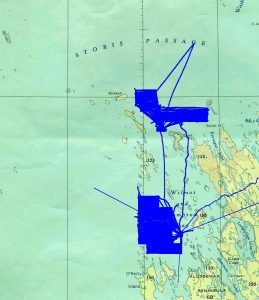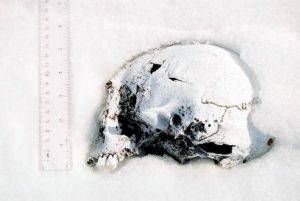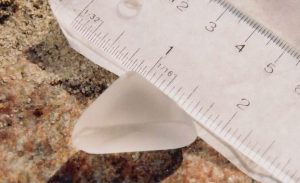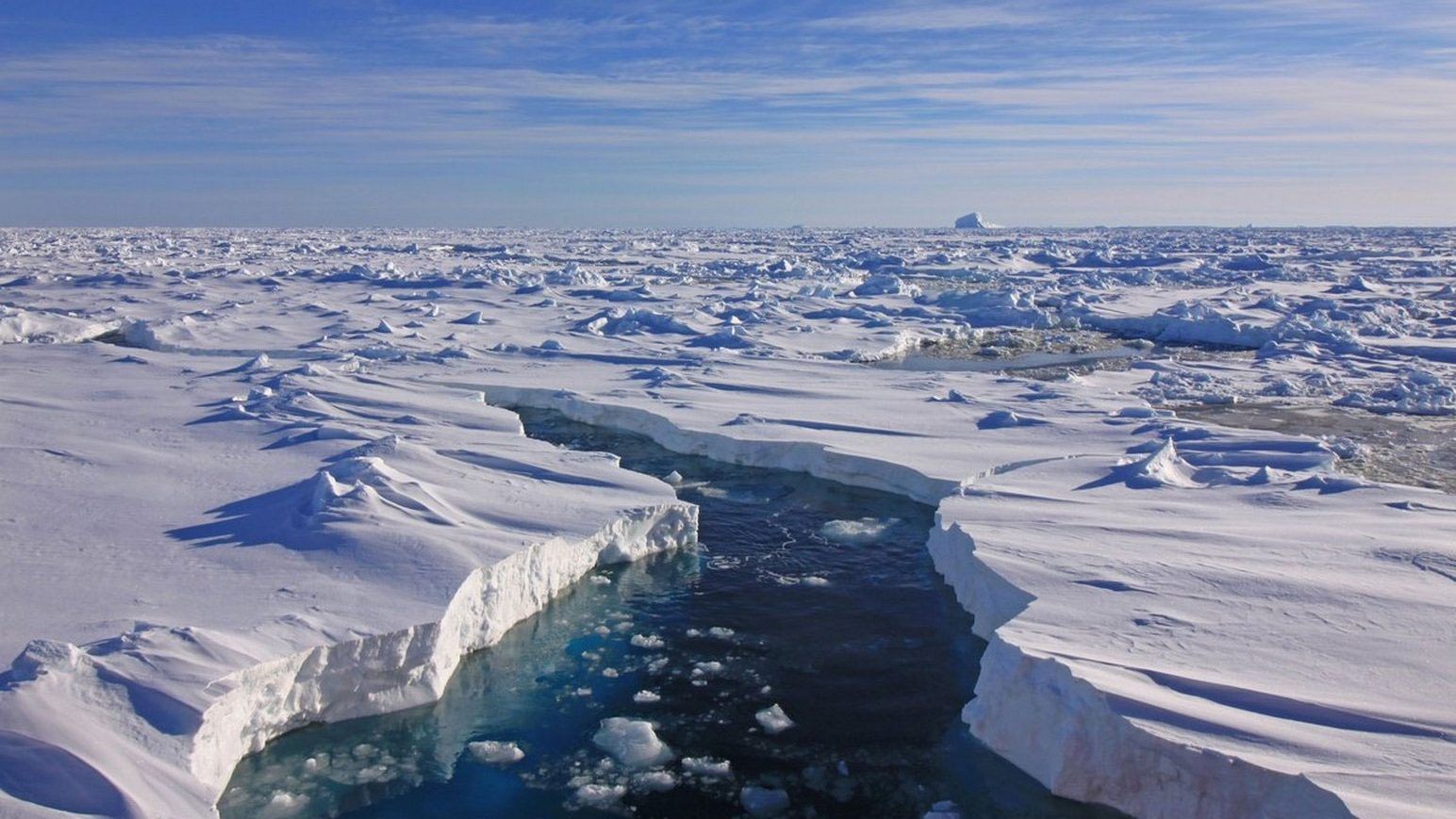Utjulik 2002 Expedition Report – ᐅᒡᔪᓕᒃ 2002 ᕿᓂᕐᓂᕐᒧᑦ ᐅᓂᒃᑳᖅ
© David C. Woodman 2002 © ᑎᕕᑎ C. ᕗᓐᒪᓐ 2002
The Utjulik 2002 expedition was organized to continue the search for the shipwreck which had been reported in 19th-century Inuit testimony as lying near the the Adelaide Peninsula. The uncertainty in the recorded testimony resulted in two possible wrecksites being identified – one to the north near Grant Point and another to the south near O’Reilly Island.
ᐅᒡᔪᓕᒃ 2001 ᕿᓂᕐᓂᕐᒧᑦ ᐱᓕᕆᐊᖑᔪᖅ ᐋᖅᑭᒃᑕᐅᓚᐅᖅᐳᖅ ᑲᔪᓯᐅᒪᐃᓐᓇᕈᑕᐅᔪᒪᑉᓗᓂ ᐅᒥᐊᕐᔪᐊᖏᖅᓯᓚᐅᖅᑐᓄᑦ ᐅᓂᒃᑳᖅᑕᐅᓚᐅᖅᑐᖅ 19 ᓯᐊᓐᑐᕆᒥ ᐃᓄᐃᑦ ᐅᖃᐅᓯᖏᑦᑎᒍᑦ ᖃᓂᒋᔭᖓᓃᓐᓂᕋᖅᑕᐅᓚᐅᖅᐳᖅ ᐊᑎᓕᓐ ᐱᓂᓐᓯᓚᑉ. ᓇᓗᓇᖅᑐᖅ ᑎᑎᕋᖅᓯᒪᔪᓂ ᓴᕿᑦᑎᔾᔪᑕᐅᓚᐅᖅᐳᖅ ᒪᕐᕈᖕᓂ ᓇᓗᓇᐃᖅᑕᐅᓂᖃᖅᖢᓂ ᐅᒥᐊᕐᔪᐊᓂᑦ ᓱᕋᒃᑐᕕᓂᕐᓂ – ᐊᑕᐅᓯᖅ ᐅᐊᖕᓇᖓᓂ ᖃᓂᒋᔭᖓ ᒍᕋᓐ ᐳᐃᓐ ᐊᒻᒪ ᐱᖃᑖ ᓂᒡᒋᐊᓂ ᐅᕋᐃᓕ ᐊᐃᓚᓐᒥ.
The most detailed description of the wrecksite was given to the Schwatka expedition (1879) -“Ikinnelikpatalok [told] of a big ship which was frozen in the ice near an island about five miles due west of Grant Point, on Adelaide Peninsula. They had to walk out about three miles on smooth ice to reach the ship.” A chart accompanying the Schwatka report implied that the ship sank near and to the west of an island due west of Grant Point.
ᐅᓂᒃᑳᖅᑕᐅᑦᑎᐊᓛᖑᔪᖅ ᐅᒥᐊᕐᔪᐊᑉ ᐊᔪ6ᓯᕝᕕᒋᓂᕋᖅᑕᐅᕝᕕᖓᓂ ᓱᕙᑎᑲ ᕿᓂᖅᑎᓪᓗᒍ (1879) – “ᐃᑭᓐᓂᓕᐸᑦᓗᒃ (ᐅᖃᐅᓯᐅᔪᖅ) ᐊᖏᔪᖅ ᐅᒥᐊᕐᔪᐊᖅ ᖁᐊᖑᓕᖅᑐᒧᑦ ᓯᑯᒥ ᐊᔪᖅᓯᓯᒪᓂᕋᖅᑕᐅᑎᓪᓗᒍ ᕿᑭᖅᑕᐅᒐᒥ ᖃᓂᒋᔭᖓᓂ 5 ᒪᐃᔭᐃᑦ ᐅᐊᓕᓂᖅᐸᓯᐊᓂ ᒍᕋᓐ ᐳᐃᓐ, ᐊᑎᓕᓐ ᐱᓂᓐᓯᓚᒥ. ᐱᓱᒋᐊᖃᓚᐅᖅᐳᑦ 3 ᒪᐃᔭᓂᒃ ᓯᑯᒥ ᒪᓂᕋᐅᑦᑎᐊᖅᑐᒥ ᐅᒥᐊᕐᔪᐊᒧᑦ ᑎᑭᑦᑐᒪᓗᑎᒃ.” ᐅᓂᒃᑳᖅᑕᐅᔪᖅ ᓱᕙᑎᑲ ᐅᓂᒃᑳᖅᑕᖓ ᐅᖃᐅᓯᖃᖅᐳᖅ ᐅᒥᐊᕐᔪᐊᖅ ᑭᕕᓚᐅᕐᓂᖓᓂᒃ ᖃᓂᒋᔭᖓᓂ ᐊᒻᒪ ᐅᐊᓕᓂᖓᓂ ᕿᑭᖅᑕᐅᒐᐅᑉ ᐅᐊᓕᓂᖅᐸᓯᐊᓂ ᒍᕋᓐ ᐳᐃᓐᑦ.
The wreck is presumably that of one of Sir John Franklin’s ships EREBUS and TERROR. These were robustly built as bomb-ketches and heavily ice-strengthened for Arctic survey work. Traditional stories concerning the circumstances of the sinking of the ship indicated that there was minimum violence done to the vessel and fostered the hope that it would still be relatively intact on the bottom. The vessels were each supplied with large iron steam engines (approximately 15 tons, producing 20-25 horsepower), and were sheathed in iron sheeting around their bows. It was hoped that this amount of metal would make them susceptible to discovery by the local effect on the earth’s magnetic field.
ᑭᕕᓂᑯ ᐃᓱᒪᒋᔭᐅᕗᖅ ᓲ ᔮᓐ ᕗᕋᐃᓚᓐ ᐅᒥᐊᕐᔪᐊᖓ ᐃᕆᐸᔅ ᐊᒻᒪ ᑎᐅᕈ ᓇᓕᑐᐃᓐᓇᖓᐅᒋᐊᒃᓴᖓᓂᒃ. ᑖᒃᑯᐊ ᓴᓐᖏᔫᑎᑕᐅᑉᓗᑎᒃ ᓴᓇᔭᐅᓚᐅᖅᐳᑦ ᐊᒻᒪ ᓯᑯᒧᑦ ᐊᒃᑐᖅᓯᔪᓐᓇᖅᑎᑕᐅᑉᓗᑎᒃ ᐅᑭᐅᖅᑕᖅᑐᒧᑦ ᑐᕌᖓᑎᑕᐅᑉᓗᑎᒃ. ᐅᓂᒃᑳᖅᑕᐅᔪᑐᖃᐃᑦ ᐅᖃᐅᓯᐅᕗᑦ ᐅᒥᐊᕐᔪᐊᖅ ᒥᑭᑦᑐᒥᒃ ᓱᕈᖅᑕᐅᓯᒪᓂᖃᕐᓂᖓᓂᒃ ᐊᒻᒪ ᐃᓱᒪᔾᔪᑕᐅᕗᖅ ᐊᑖᓂ ᐃᒪᐅᑉ ᓱᕈᖅᓯᒪᓗᐊᓐᖏᓪᓗᓂ ᓇᓂᔭᐅᓇᔭᕆᐊᒃᓴᖓᓂᒃ. ᐅᒥᐊᕐᔪᐊᑦ ᐊᖏᔪᓂᒃ ᓴᕕᖕᓂᒃ ᐃᑯᒪᖃᓚᐅᖅᐳᑦ (15 ᑕᓐᓂᒃ, 20-25 ᕼᐅᐊᔅ ᐸᐅᕙᖃᖅᖢᑎᒃ) ᐊᒻᒪ ᓴᕕᖃᐅᖅᖢᑎᒃ ᐊᕙᓗᖏᓐᓂ. ᐃᓱᒪᓚᐅᕋᓗᐊᖅᐳᑦ ᓂᐱᑦᑕᖅᑐᒃᑯᑦ ᕿᓂᕈᑕᐅᔪᒃᑯᑦ ᓇᓂᔭᒃᓴᐅᒋᐊᒃᓴᖏᓐᓂᒃ ᓄᓇᒥᑦ.
The 2002 expedition was primarily sponsored with private funds. The field party was comprised mainly of veterans of the Utjulik 2001 survey. The team was again led by Captain David Woodman who was accompanied by Ms. Amie Gibbins, Mr. Tom Gross, and Mr. Bill Robinson. Mr. Saul Aksalook of Gjoa Haven, who had also been on the 2001 team as a Ranger participant, was hired as chief guide for the party. The new members of the team were Mr. Kevin Cronin and Mr. John Murray of Ireland.
2001-ᒥ ᕿᓂᕐᓂᐅᔪᖅ ᐱᓕᕆᐊᖑᓚᐅᖅᐳᖅ ᐃᖕᒥᒃᑰᖅᑐᑦ ᑮᓇᐅᔭᖃᕐᕕᐅᑎᓪᓗᒋᑦ.
ᐃᓚᐅᔪᑦ ᑕᒪᐃᓐᓂᖃᔭᖅ ᐅᑦᔪᓕᒃ 2001 ᒥ ᐊᐅᓪᓚᖃᑕᐅᓚᐅᖅᐳᑦ ᖃᐅᔨᓴᖅᑕᐅᔪᕕᓂᕐᓂ ᐃᓚᐅᑉᓗᑎᒃ. ᐊᐅᓪᓚᖅᑐᑦ ᖃᐅᔨᓴᐃᒋᐊᖅᑐᖅᖢᑎᒃ ᓯᕗᓕᖅᑎᖃᓚᐅᖅᐳᑦ ᑎᕕᑎ ᕗᑦᒪᓐᒥᒃ ᐃᓚᖃᓚᐅᖅᐳᖅ ᒥᔅ ᐊᐃᒥ ᒋᑉᓴᓐ, ᒥᔅᑕ ᑖᒻ ᒍᕈᔅ, ᐊᒻᒪ ᒥᔅᑕ ᐱᐅ ᕌᐳᑦᓴᓐ. ᒥᔅᑕ ᓴᓪ ᐊᒃᓴᓗᒃ ᐅᖅᓱᖅᑑᒥᑦ, ᐃᓚᐅᓚᐅᕐᒥᔪᖅ ᖃᐅᔨᓴᖅᑎᐅᑉᓗᓂ 2001 ᒥ ᐃᓚᐅᓚᐅᕆᕗᖅ. ᐃᖃᓇᐃᔭᖅᑎᒋᔭᐅᑉᓗᓂ ᐊᖓᔪᖅᑳᖑᑉᓗᓂ ᐊᐅᓪᓚᖅᑐᓄᑦ. ᐃᓚᐅᓕᓵᖅᑐᑦ ᒥᔅᑕ ᑭᐊᕙᓐ ᑯᕈᓂᒃ ᐊᒻᒪ ᒥᔅᑕ ᔭᓐ ᒧᕆ ᐊᐃᕈᓚᓐᒥᑦ.
Equipment used in the field survey consisted of the Scintrex Smartmag 4 portable cesium magnetometer. Two SM4 magnetometers were sled mounted as a gradiometer and towed behind a snowmobile over the sea ice. It was determined that with the magnetometer mounted on a sled pulled 10m behind a snowmobile that a 200m line spacing should be adequate to detect the expected signal.
ᐱᖁᑎᑦ ᐊᑐᖅᑕᐅᔪᑦ ᐊᐅᓪᓚᖅᓯᒪᔾᔪᑕᐅᑉᓗᑎᒃ ᓯᓂᑎᕆᒃ ᓯᒪᑦᒪᒡᒥ ᓯᑕᒪᑦ ᓄᒃᑎᖅᑕᐅᔪᓐᓇᖅᑐᑦ ᓂᐱᑦᑕᖅᑐᐃᑦ. ᒪᕐᕈᒃ SM4 ᒥᒃ ᓈᓴᐅᑎᖃᖅᑐᖅ ᐅᑭᐅᖅᑕᖅᑐᑉ ᖁᓛᓄᑦ ᓂᐱᑦᑕᖅᑐᖃᖅᑐᓂᒃ ᐊᔾᔨᖓᓂᒃ ᖃᐅᔨᓴᕈᑕᐅᔪᖅ ᖃᒧᑎᒧᐊᖅᑕᐅᑉᓗᑎᒃ ᐊᑐᖅᑕᐅᓚᐅᖅᐳᒃ ᐊᒻᒪ ᓯᑭᑑᒃᑯᑦ ᐊᒡᔭᖅᑕᐅᑉᓗᑎᒃ ᓯᑯᒃᑯᑦ ᑕᕆᐅᒃᑯᑦ. ᓇᓗᓇᐃᖅᓯᓚᐅᖅᐳᑦ ᓂᐱᑦᑕᖅᑐᓕᕆᔾᔪᓯᐅᔪᖅ ᐃᓕᔭᐅᓯᒪᔪᖅ ᖃᒧᑎᒧᑦ ᐅᓂᐊᖅᑕᐅᔪᖅ 10 ᒦᑕᓂᒃ ᓯᑭᑐᒥᑦ ᓇᓂᓯᔾᔪᑕᐅᓇᔭᕆᐊᒃᓴᖓᓂᒃ 200 ᒦᑕᓂᒃ ᖃᐅᔨᔾᔪᑕᐅᓗᓂ ᓂᐱᐅᓇᔭᖅᑐᒥᒃ.
The expedition arrived in Gjoa Haven on 29 April 2002 and stayed in the field until May 19th. In all the survey completed 1627 km of survey line at an average speed of 10 km/hr and covered over 151 km2 of area. The first week was devoted to resurveying the seven high-priority targets from the 2001 expedition at 50m spacing. Five of these targets were eliminated from further consideration. The last ten days were spent in surveying a new area near O’Reilly Is. at 200m spacing, and six new priority targets were identified. It is felt that the area was covered with sufficient accuracy to preclude “missing” a target with the wreck’s expected characteristics. Along with the two remaining northern targets these new sites will be investigated by sonar and underwater cameras in a future expedition.
ᐊᐅᓪᓚᕐᓂᐊᖅᑐᑦ ᑎᑭᓚᐅᖅᐳᑦ ᐅᖅᓱᖅᑑᒧᑦ 29 ᒥ ᐃᐳᕈᓪ 2002 ᐊᒻᒪ ᐊᐅᓪᓚᖅᓯᒪᑉᓗᑎᒃ ᒪᐃ 19 ᒧᑦ ᑎᑭᓪᖢᒍ. ᑕᒪᐃᓐᓂ ᖃᐅᔨᓴᖅᑕᐅᔪᒥ 1627 ᑭᓚᒥᑕᓂᒃ ᖃᐅᔨᓴᐃᓚᐅᖅᐳᑦ ᓇᑭᕐᓂᖃᖅᖢᓂ 10 ᑭᓛᒥᑕ/ᐃᑲᕐᕋᓂᒃ ᐊᒻᒪ ᐃᖏᕐᕋᑉᓗᑎᒃ 151 ᑭᓚᒥᑕ2-ᓂᒃ ᐃᓂᐅᔪᓂ.
ᓯᕗᓪᓕᖅ ᐱᓇᓱᐊᕈᓯᖅ ᖃᐅᔨᓴᐃᒃᑲᓐᓂᕈᑕᐅᓚᐅᖅᐳᖅ 7 ᖑᔪᓄᑦ ᓯᕗᓪᓕᐅᑎᑕᐅᔪᓄᑦ ᖃᐅᔨᓴᖅᑕᐅᔪᒃᓴᓄᑦ 2001 ᒥ ᖃᐅᔨᓴᖅᑕᐅᓂᐊᖅᑐᓄᑦ 50 ᒥᑕ ᐅᖓᓯᖕᓂᖃᐅᖅᑐᓂ. ᑕᓪᓕᒪᑦ ᖃᐅᔨᓴᖅᑕᐅᔪᑦ ᐊᑐᕈᓐᓇᐃᖅᑎᑕᐅᓚᐅᖅᐳᑦ ᓕᕆᐊᖑᒃᑲᓐᓂᕐᓂᐊᕈᓐᓇᐃᖅᖢᑎᒃ ᐃᓱᒪᒃᓴᖅᓯᐅᕈᑕᐅᒋᐊᖃᕈᓐᓇᐃᖅᑎᑕᐅᑉᓗᑎᒃ. ᐅᑉᓗᑦ ᖁᓕᐅᔪᑦ ᑭᖑᓪᓕᖅᐹᖑᔪᑦ ᐱᓕᕆᐊᖃᕈᓯᐅᓚᐅᖅᐳᑦ ᖃᐅᔨᓴᐃᔾᔪᓯᐅᑉᓗᑎᒃ ᐅᕋᐃᓕ ᐊᐃᒪᓐᓂ 200 ᒥᑕᓂᒃ ᓯᕕᑐᓂᖃᖅᖢᑎᒃ, ᐊᒻᒪ ᐊᕐᕕᓂᓖᑦ ᓯᕗᓪᓕᐅᑎᑕᐅᖁᔭᐅᔪᑦ ᓇᓗᓇᐃᖅᑕᐅᓚᐅᖅᐳᑦ. ᐃᓱᒪᓚᐅᖅᐳᑦ ᐃᓂᐅᔪᖅ ᖃᐅᔨᓴᐃᕝᕕᐅᓗᓂ ᓇᓚᐅᑕᐅᓯᒪᒋᐊᒃᓴᖓᓂᒃ “ᑐᖓᐅᑦᑎᕝᕕᐅᓇᔭᓐᖏᓐᓂᖓ” ᐅᒥᐊᕐᔪᐊᒥᒃ ᑯᕕᔪᒥᑦ ᐃᓗᓕᕆᔭᐅᔪᓂᑦ ᐃᓱᒪᒋᔭᐅᓚᐅᖅᐳᖅ. ᒪᕐᕈᖕᓂᒃ ᐃᓚᖃᖅᖢᑎᒃ ᑐᕌᕐᕕᐅᔪᒪᔪᓂ ᑖᒃᑯᐊᒃ ᐃᓂᐅᔪᒃ ᖃᐅᔨᓴᖅᑕᐅᓂᐊᖅᐳᑦ ᓈᓚᐅᑎᑎᑐᑦ ᖃᐅᓴᐃᔾᔪᓯᕐᓄᑦ ᐊᒻᒪ ᐊᑖᓂ ᐃᒪᐅᑉ ᐃᓗᐊᓂ ᐊᔾᔨᓕᐅᕈᑎᒃᑯᑦ ᖃᑯᒍᓐᖑᒃᑲᓐᓂᖅᐸᑦ ᖃᐅᔨᓴᐃᔪᓂ.

Figure 1: This chart shows the area covered by the 2002 survey.
ᑎᑎᕋᐅᔭᖅᓯᒪᔪᖅ 1: ᑖᓐᓇ ᓈᓴᐅᑎᖃᖅᑐᖅ ᑕᑯᒃᓴᐅᑎᑦᑎᕗᖅ ᐃᓂᐅᔪᓂᒃ ᖃᐅᔨᓴᖅᑕᐅᓚᐅᖅᑐᓂᒃ 2002 ᒥ ᖃᐅᔨᓴᖅᑕᐅᔪᓂ.
While camped at an un-named island in Wilmot Bay the party conducted a surface search for possible Franklin artifacts. As well as relocating the human skull intially found during the Eco-Nova expedition of 1997, they found three rectangular tent sites and a small piece of glass which might have come from an optical instrument.
ᐊᑎᖃᓐᖏᑦᑐᒥ ᑕᖕᒫᖅᑎᓪᓗᒋᑦ ᕕᐅᒪᑦ ᐸᐃᒥ ᐊᐅᓪᓚᖅᓯᒪᔪᑦ ᒪᓂᕋᐅᑉ ᖄᖓᓂ ᖃᐅᔨᓴᐃᓚᐅᖅᐳᑦ ᕗᕋᐃᓚᓐ ᐃᑦᑕᕐᓂᑕᖏᓐᓂᒃ ᑕᑯᔪᒪᑉᓗᑎᒃ. ᐊᒻᒪ ᓇᓂᔭᐅᒃᑲᓐᓂᖅᑎᓪᓗᒍ ᐃᓅᑉ ᓂᐊᖁᕕᓂᖓ ᐃᑯ-ᓄᕙ ᕿᓂᖅᑎᓪᓗᒋᑦ 1997 ᒥ, ᐱᖓᓱᓂᒃ ᑐᐱᕐᕕᕕᓂᕐᓂᒃ ᓇᓂᓯᓚᐅᐳᑦ ᑭᑉᐹᕆᒃᑐᓂᒃ ᐊᒻᒪ ᒥᑭᔪᒥᒃ ᐊᓕᒍᕐᒥᒃ ᐃᒻᒪᖄ ᐃᒡᒑᒋᔭᐅᔪᕕᓂᖅ.


Figure 2: A skull, some tent sites, and a small piece of glass were found on shore searches.
ᑎᑎᕋᐅᔭᖅᓯᒪᔪᖅ 2: ᓂᐊᖁᕕᓂᖅ ᐃᓄᖕᒧᑦ, ᑐᐱᕐᕕᕕᓂᑦ, ᐊᒻᒪ ᒥᑭᑦᑐᖅ ᐊᓕᒍᖅ ᓇᓂᔭᐅᓚᐅᖅᐳᖅ ᓯᒡᔭᒥ ᕿᓂᖅᑎᓪᓗᒋᑦ.
